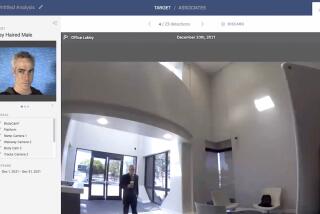Turning a Computer Into a Better Vault
- Share via
Just as the outlaws of the Old West spurred security companies to design better vaults, modern-day electronic bandits are inspiring the development of advanced computer security gadgetry.
The most sophisticated new equipment includes biometric machinery--products that verify the identity of would-be computer users by analyzing their unique physical characteristics.
Among the offerings is an eye-scanning device that detects the unique blood vessel patterns in the retina, a sort of “eye signature.” Made by EyeDentify, an Oregon firm, it is designed to restrict access to computer databases.
To use a computer equipped with the scanner, you first have to look through a scope. The scanner then takes a reading of your retina. It grants computer access only to authorized users whose blood vessel patterns have been recorded and stored in its electronic memory.
Other biometric devices work on the same principle. For example, Palo Alto-based Identix Inc. produces devices that use fingerprints to control access to computers. Your fingerprint is read by a rectangular sensor about the size of a large index card.
A Boston company, Ecco Industries, manufactures voice-based identity verification equipment.
How far can biometric technology go? Some companies are experimenting with lasers to scan people’s cells for genetic characteristics to determine who should be granted computer access.
Other access control equipment relies more on the way people do things rather than on their biology. For example, there are devices that read signatures based on writing patterns, speed and pen-to-pad pressure. Similarly, there is an identity verification gadget designed to distinguish a “keyboard signature”--an individual’s typing speed, acceleration patterns and finger-to-key pressure.
In addition, there are systems that rely on identification cards, much like the banking industry’s automated teller machines.
While these new devices are becoming more popular, the use of passwords is still the most common means of controlling computer access. Many companies assign a password--typically a one-word code--to their computer-using employees. To gain access to computer data, employees type these passwords on the computer keyboard.
However, the password system also has been advanced. There are circuit-bearing “smart cards” for traveling employees who use a personal computer to communicate with the company’s main computer. These cards flash the password needed to gain access to the main computer. What’s more, they flash new passwords continuously, a feature designed to thwart intruders who try to gain computer access by guessing or stealing the code. Typically, the passwords change one to four times a minute.
Such access controls are sufficient for many companies, but some corporations--firms involved in top-secret U.S. Defense Department contracting, for example--provide an extra layer of protection. They install cryptographic ciphers, equipment that turns English into a gibberish-like code.
The devices, used when sensitive data is transmitted from one computer to another, are intended to thwart industrial spies who try to intercept messages. Another device translates the code back to readable form.
Meanwhile, the work goes on to develop even more sophisticated computer protection. “Companies are still trying to build a better vault,” said Richard Rueb, executive director of the Newport Beach-based Information Systems Security Assn.






